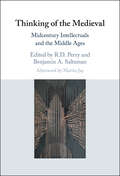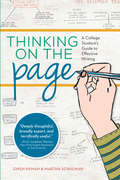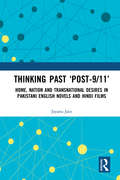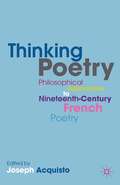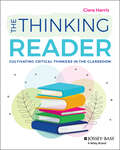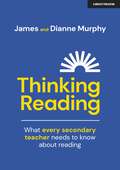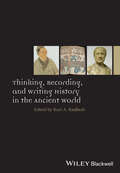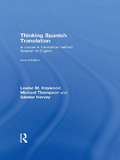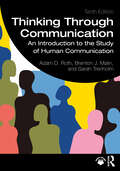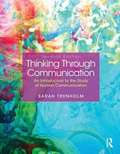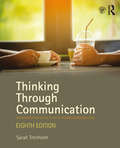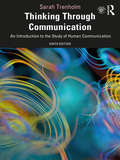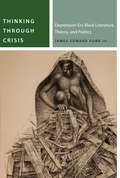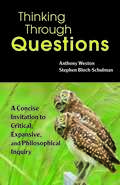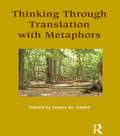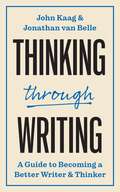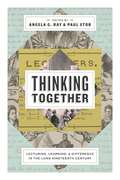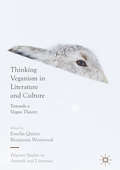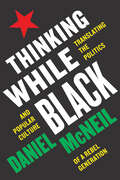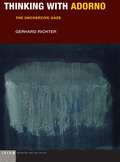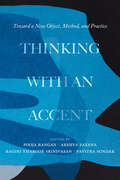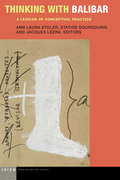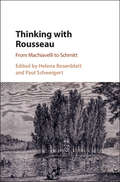- Table View
- List View
Thinking of the Medieval: Midcentury Intellectuals and the Middle Ages
by Perry Benjamin A. SaltzmanThe mid-twentieth century gave rise to a rich array of new approaches to the study of the Middle Ages by both professional medievalists and those more well-known from other pursuits, many of whom continue to exert their influence over politics, art, and history today. Attending to the work of a diverse and transnational group of intellectuals – Hannah Arendt, Erich Auerbach, W. E. B. Du Bois, Frantz Fanon, Erwin Panofsky, Simone Weil, among others – the essays in this volume shed light on these thinkers in relation to one another and on the persistence of their legacies in our own time. This interdisciplinary collection gives us a fuller and clearer sense of how these figures made some of their most enduring contributions with medieval culture in mind. Thinking of the Medieval is a timely reminder of just how vital the Middle Ages have been in shaping modern thought.
Thinking on the Page: A College Student's Guide to Effective Writing
by Gwen Hyman Martha SchulmanTake Charge of Your Writing--and Dazzle Your Instructors! It can be a challenge to achieve writing excellence, but it doesn't have to be mysterious, and it's definitely not impossible. To present powerful ideas effectively in your college essays, you need to break away from rigid rules and structures and start thinking on the page. With this book, you'll learn how to actively engage with a text, analyze it, draw informed conclusions, and then make solid claims about what you have observed. Thinking on the Page will also help you: Think critically about what you're reading and draw questions and ideas directly from the text Approach your essay as a story rather than a formula Work through your ideas by graphing, listing, charting, and drawing Incorporate relevant outside research Edit your final essay and polish it to perfection Whether you're in college or high school, you need to communicate your ideas effectively through writing. Thinking on the Page provides innovative tools tailored to the way you learn and write, enabling you to produce thoughtful, analytical, and meaningful work, both in school and beyond.
Thinking Past ‘Post-9/11’: Home, Nation and Transnational Desires in Pakistani English Novels and Hindi Films
by Jayana JainThis book offers new ways of constellating the literary and cinematic delineations of Indian and Pakistani Muslim diasporic and migrant trajectories narrated in the two decades after the 9/11 attacks. Focusing on four Pakistani English novels and four Indian Hindi films, it examines the aesthetic complexities of staging the historical nexus of global conflicts and unravels the multiple layers of discourses underlying the notions of diaspora, citizenship, nation and home. It scrutinises the “flirtatious” nature of transnational desires and their role in building glocal safety valves for inclusion and archiving a planetary vision of trauma. It also provides a fresh perspective on the role of Pakistani English novels and mainstream Hindi films in tracing the multiple origins and shifts in national xenophobic practices, and negotiating multiple modalities of political and cultural belonging. It discusses various books and films including The Reluctant Fundamentalist, Burnt Shadows, My Name is Khan, New York, Exit West, Home Fire, AirLift and Tiger Zinda Hai. In light of the twentieth anniversary of 9/11 attacks, current debates on terror, war, paranoid national imaginaries and the suspicion towards migratory movements of refugees, this book makes a significant contribution to the interdisciplinary debates on border controls and human precarity. A crucial work in transnational and diaspora criticism, it will be of great interest to researchers of literature and culture studies, media studies, politics, film studies, and South Asian studies.
Thinking Poetry: Philosophical Approaches to Nineteenth-Century French Poetry
by Joseph AcquistoThis volume of essays seeks to establish a dialogue between poetry and philosophy where each could be said to read the other and announces important new paths for a reinvigorated study of lyric poetry in the decades to come.
The Thinking Reader: Cultivating Critical Thinkers in the Classroom
by Ciera HarrisConcepts, lesson plans, and strategies for making reading lessons work The Thinking Reader: Cultivating Critical Thinkers in the Classroom is the frazzled teacher's guide to setting up any grade 2-4 classroom for reading success. You won't find any busywork, condescending lectures, or boring worksheets in this book. Instead, you'll learn flexible reading strategies to blend into your lessons at the start of the school year that will support your students for years to come. This book also debunks old-school ideas about reading instruction and explains the concepts that you'll need to know as you help students build a foundation for their future as readers. Former elementary teacher and instructional coach Ciera Harris has achieved remarkable, replicable results with young readers, not with a rigid system or program, but with a new approach to thinking about reading. In this book, you'll learn why it makes sense to go beyond all the lessons of phonics, fluency, and vocabulary by making reading personal to each student. This easy-to-use approach has helped teachers across the country create a culture of reading within their classrooms, so students—even those that struggle the most with reading—can start view themselves as readers. Help students learn based on what interests them, as individuals, and watch budding readers bloom. Discover why reading is not a series of decoding skills, but a personal, powerful act of thinking Learn the steps to setting up your classroom for reading success at the beginning of the year Get engaging lesson plans and techniques for implementing primary reading strategies like schema, asking questions, metacognition, and so much more Overcome common roadblocks, including student resistance to reading With The Thinking Reader, elementary school teachers in grades 2-4 can build the ultimate framework for reading success.
Thinking Reading: What every secondary teacher needs to know about reading
by Dianne Murphy James MurphyDespite the efforts of teachers and educators, every year secondary schools across the English-speaking world turn out millions of functionally illiterate leavers. The costs in human misery and in wasted productivity are catastrophic. What can schools do to prevent this situation? In this highly accessible book James and Dianne Murphy combine more than 50 years of experience to provide teachers with a thorough, easy to use introduction to the extensive research on reading and its effects on student achievement. Drawing on the work of experts from around the world, the authors explore how we learn to read, how the many myths and misconceptions around reading developed, and why they continue to persist.Building on these foundations chapters go on to examine how the general secondary school classroom can support all levels of reading more effectively, regardless of subject; how school leaders can ensure that their systems, practices and school culture deliver the very best literacy provision for all students; and what it takes to ensure that a racing intervention aimed at adolescent struggling readers is truly effective. The overall message of this books is one of great optimism: the authors demonstrate that the right of every child to learn to read is entirely achievable if schools employ the best research-driven practice.
Thinking Reading: What every secondary teacher needs to know about reading
by Dianne Murphy James MurphyDespite the efforts of teachers and educators, every year secondary schools across the English-speaking world turn out millions of functionally illiterate leavers. The costs in human misery and in wasted productivity are catastrophic. What can schools do to prevent this situation? In this highly accessible book James and Dianne Murphy combine more than 50 years of experience to provide teachers with a thorough, easy to use introduction to the extensive research on reading and its effects on student achievement. Drawing on the work of experts from around the world, the authors explore how we learn to read, how the many myths and misconceptions around reading developed, and why they continue to persist.Building on these foundations chapters go on to examine how the general secondary school classroom can support all levels of reading more effectively, regardless of subject; how school leaders can ensure that their systems, practices and school culture deliver the very best literacy provision for all students; and what it takes to ensure that a racing intervention aimed at adolescent struggling readers is truly effective. The overall message of this books is one of great optimism: the authors demonstrate that the right of every child to learn to read is entirely achievable if schools employ the best research-driven practice.
Thinking, Recording, and Writing History in the Ancient World (Ancient World: Comparative Histories #8)
by Kurt A. RaaflaubThinking, Recording, and Writing History in the Ancient World presents a cross-cultural comparison of the ways in which ancient civilizations thought about the past and recorded their own histories. Written by an international group of scholars working in many disciplines Truly cross-cultural, covering historical thinking and writing in ancient or early cultures across in East, South, and West Asia, the Mediterranean, and the Americas Includes historiography shaped by religious perspectives, including Judaism, early Christianity, Islam, and Buddhism
Thinking Spanish Translation: A Course in Translation Method: Spanish to English (Thinking Translation)
by Louise Haywood Michael Thompson Sándor HerveyThe new edition of this comprehensive course in Spanish-English translation offers advanced students of Spanish a challenging yet practical approach to the acquisition of translation skills, with clear explanations of the theoretical issues involved. A variety of translation issues are addressed, including: cultural differences register and dialect grammatical differences genre. With a sharper focus, clearer definitions and an increased emphasis on up-to-date ‘real world’ translation tasks, this second edition features a wealth of relevant illustrative material taken from a wide range of sources, both Latin American and Spanish, including: technical, scientific and legal texts journalistic and informative texts literary and dramatic texts. Each chapter includes suggestions for classroom discussion and a set of practical exercises designed to explore issues and consolidate skills. Model translations, notes and suggestions for teaching and assessment are provided in a Teachers’ Handbook; this is available for free download at http://www.routledge.com/cw/thinkingtranslation/ Thinking Spanish Translation is essential reading for advanced undergraduate and postgraduate students of Spanish and translation studies. The book will also appeal to a wide range of language students and tutors through the general discussion of the principles and purposes of translation.
Thinking Through Communication: An Introduction to the Study of Human Communication
by Adam Roth Brenton Malin Sarah TrenholmThis fully updated tenth edition for hybrid introductory communication courses provides a balanced introduction to the fundamental theories and principles of communication.The book explores communication in a variety of contexts, including interpersonal, group, organizational, and mass media. It provides students with the theoretical knowledge and the research and critical thinking skills they will need to succeed in advanced communication courses and professions. Organized into three parts, this new edition first explores the history of communication studies and explains the basic perspectives used by scholars in the field. Part II looks at how language and listening take place in small and large groups. Part III then examines global, institutional, and public communication. This edition includes an additional chapter on research methods, reflects the changing nature and norms of communication in the workplace, and provides a post-COVID assessment of models, methods, and evaluations of telecommuting practices. The appendix gives users the flexibility to tailor their courses to the interests and needs of their students, offering guidelines for preparing and presenting public presentations and giving examples of major research methods.Thinking Through Communication is an ideal textbook for Introduction to Communication courses that aim to provide a comprehensive overview of the field.Material for instructors including PowerPoint slides, test questions, and an instructor’s manual are available at www.routledge.com/9781032499079.
Thinking Through Communication
by Sarah TrenholmPraised for its teachability, Thinking Through Communication provides an excellent, balanced introduction to basic theories and principles of communication, making sense of a complex field through a variety of approaches. In an organized and coherent manner, Thinking Through Communication covers a full range of topics- from the history of communication study to the methods used by current communication scholars to understand human interaction. The text explores communication in a variety of traditional contexts: interpersonal, group, organizational, public, intercultural, computer-mediated communication and the mass media. This edition also offers new insights into public speaking and listening. This text can be used successfully in both theory- and skills-based courses. Written in a clear, lively style, Trenholm's overall approach-including her use of examples and interesting illustrations-helps both majors and non-majors alike develop a better understanding of communication as a field of study and an appreciation for ways in which communication impacts their daily lives.
Thinking Through Communication: An Introduction to the Study of Human Communication (Mycommunicationkit Ser.)
by Sarah TrenholmNow in its eighth edition, Thinking Through Communication provides a balanced introduction to the fundamental theories and principles of communication. It explores communication in a variety of contexts—from interpersonal to group to mass media—and can be used in both theoryand skills-based courses. With a dynamic approach, Trenholm helps students to develop a better understanding of communication as a field of study, as well as its practical applications. This edition devotes attention to how new technologies are changing the ways we think about communication, with revised chapters on both traditional and social media.
Thinking Through Communication: An Introduction to the Study of Human Communication
by Sarah TrenholmThe ninth edition of this textbook for hybrid introductory communication courses provides a balanced introduction to the fundamental theories and principles of communication. The book explores communication in a variety of contexts—including interpersonal, group, organizational, and mass media—and provides students the theoretical knowledge and the research and critical thinking skills they’ll need to succeed in advanced communication courses and professions. The first section explores the history of communication study and explains basic perspectives used by scholars in the field. The second looks at how communicators decode and encode messages, while the third examines channels and contexts, from interpersonal to mass media. This edition devotes attention to how new technologies are changing the ways we think about communication, with revised and updated examples, and gives special attention to relevant critical theory. Two appendices give users the flexibility to tailor their courses to the interests and needs of their students, offering guidelines for preparing and presenting public presentations and giving examples of major research methods. Thinking Through Communication is an ideal textbook for Introduction to Communication courses that aim to provide a comprehensive overview of the field. A companion website for instructors containing PowerPoint slides, test questions, and an instructor’s manual is available at https://routledgetextbooks.com/textbooks/9780367857011.
Thinking Through Crisis: Depression-Era Black Literature, Theory, and Politics (Commonalities)
by James Edward Ford IIIWinner, 2020 William Sanders Scarborough Prize, Modern Language AssociationHonorable Mention, MSA First Book PrizeIn Thinking Through Crisis, James Edward Ford III examines the works of Richard Wright, Ida B. Wells, W. E. B. Du Bois, Zora Neale Hurston, and Langston Hughes during the 1930s in order to articulate a materialist theory of trauma. Ford highlights the dark proletariat’s emergence from the multitude apposite to white supremacist agendas. In these works, Ford argues, proletarian, modernist, and surrealist aesthetics transform fugitive slaves, sharecroppers, leased convicts, levee workers, and activist intellectuals into protagonists of anti-racist and anti-capitalist movements in the United States.Thinking Through Crisis intervenes in debates on the 1930s, radical subjectivity, and states of emergency. It will be of interest to scholars of American literature, African American literature, proletarian literature, black studies, trauma theory, and political theory.
Thinking Through Questions: A Concise Invitation to Critical, Expansive, and Philosophical Inquiry
by Anthony Weston Stephen Bloch-SchulmanThinking Through Questions is an accessible and compact guide to the art of questioning, covering both the use and abuse of questions. Animated by wide-ranging and engaging exercises and examples, the book helps students deepen their understanding of how questions work and what questions do, and builds the skills needed to ask better questions. Cowritten by two of today's leading philosopher-teachers, Thinking Through Questions is specifically designed to complement, connect, and motivate today&’s standard curricula, especially for classes in critical thinking, philosophical questioning, and creative problem- solving (called here "expansive questioning"). Offering students a wide and appreciative look at questions and questioning, this small book will also appeal to faculty and students across the disciplines: in college writing courses, creativity workshops, education schools, introductions to college thinking, design thinking projects, and humanities and thinking classes. Open-ended, creative, and critically self-possessed thinking is its constant theme—what field doesn&’t need more of that?
Thinking Through Translation with Metaphors
by James St. AndréThinking through Translation with Metaphors explores a wide range of metaphorical figures used to describe the translation process, from Aristotle to the present. Most practitioners and theorists of translation are familiar with a number of metaphors for translation, such as the metaphor of the bridge, following in another's footsteps, performing a musical score, changing clothes, or painting a portrait; yet relatively little attention has been paid to what these metaphorical models reveal about how we conceptualize translation. Drawing on insights from recent developments in metaphor theory, contributors to this volume reveal how central metaphorical language has been to translation studies at all periods of time and in various cultures. Metaphors have played a key role in shaping the way in which we understand translation, determining what facets of the translation process are deemed to be important and therefore merit study, and aiding in the training of successive generations of translators and theorists. While some of the papers focus mainly on past metaphorical representations, others discuss recent shifts in both metaphor and translation theory, while others still propose innovative metaphors in a bid to transform translation studies. The volume also includes an annotated bibliography of works centrally concerned with metaphors of translation.
Thinking through Writing: A Guide to Becoming a Better Writer and Thinker (Skills for Scholars #5)
by John Kaag Jonathan van BelleA concise and practical manual on developing reading, writing, and critical thinking skills in tandem For college students learning how to write on scholarly subjects, writing and critical thinking go hand in hand. And yet most books on these topics are categorized separately: writing guides and critical thinking handbooks. This book is different, offering a manual for developing reading, writing, and thinking skills in tandem. With short, practical chapters, Thinking through Writing helps readers learn to think critically about themselves and the world at large, read carefully and get the necessary literary support, write clearly and persuasively, stay on point, and finish their work as cleanly and compellingly as possible. Drawing on years of teaching critical thinking and writing, including almost a decade of teaching Harvard&’s freshman expository writing course, the authors invite readers to consider the intimate relationship between thinking and the creative, critical, self-actualizing act of writing.• Interviews with some of the most interesting and brilliant writers working today• Advice on how to structure an argument, write for an audience, work through writer&’s block and anxiety, and much more• Tips on how to make your writing unique and personal• Exercises and templates to help novice writers reach their full potential in practice
Thinking Together: Lecturing, Learning, and Difference in the Long Nineteenth Century (Rhetoric and Democratic Deliberation #16)
by Angela G. Ray Paul StobChanges to the landscape of higher education in the United States over the past decades have urged scholars grappling with issues of privilege, inequality, and social immobility to think differently about how we learn and deliberate. Thinking Together is a multidisciplinary conversation about how people approached similar questions of learning and difference in the nineteenth century.In the open air, in homes, in public halls, and even in prisons, people pondered recurring issues: justice, equality, careers, entertainment, war and peace, life and death, heaven and hell, the role of education, and the nature of humanity itself. Paying special attention to the dynamics of race and gender in intellectual settings, the contributors to this volume consider how myriad groups and individuals—many of whom lived on the margins of society and had limited access to formal education—developed and deployed knowledge useful for public participation and public advocacy around these concerns. Essays examine examples such as the women and men who engaged lecture culture during the Civil War; Irish immigrants who gathered to assess their relationship to the politics and society of the New World; African American women and men who used music and theater to challenge the white gaze; and settler-colonists in Liberia who created forums for envisioning a new existence in Africa and their relationship to a U.S. homeland. Taken together, this interdisciplinary exploration shows how learning functioned not only as an instrument for public action but also as a way to forge meaningful ties with others and to affirm the value of an intellectual life.By highlighting people, places, and purposes that diversified public discourse, Thinking Together offers scholars across the humanities new insights and perspectives on how difference enhances the human project of thinking together.
Thinking Veganism in Literature and Culture: Towards A Vegan Theory (Palgrave Studies in Animals and Literature)
by Benjamin Westwood Emelia QuinnThis collection explores what the social and philosophical aspects of veganism offer to critical theory. Bringing together leading and emerging scholars working in animal studies and critical animal studies, Thinking Veganism in Literature and Culture shows how the experience of being vegan, and the conditions of thought fostered by veganism, pose new questions for work across multiple disciplines. Offering accounts of veganism which move beyond contemporary conceptualizations of it as a faddish dietary preference or set of proscriptions, it explores the messiness and necessary contradictions involved in thinking about or practicing a vegan way of life. By thinking through as well as about veganism, the project establishes the value of a vegan mode of reading, writing, looking, and thinking.
Thinking While Black: Translating the Politics and Popular Culture of a Rebel Generation
by Daniel McNeilThinking While Black brings together the work and ideas of the most notorious film critic in America, one of the most influential intellectuals in the United Kingdom, and a political and cultural generation that consumed images of rebellion and revolution around the world as young Black teenagers in the late 1960s. Drawing on hidden and little known archives of resistance and resilience, it sheds new light on the politics and poetics of young people who came together, often outside of conventional politics, to rock against racism in the 1970s and early ‘80s. It re-examines debates in the 1980s and ‘90s about artists who “spread out” to mount aggressive challenges to a straight, white, middle-class world, and entertainers who “sold out” to build their global brands with performances that attacked the Black poor, rejected public displays of introspection, and expressed unambiguous misogyny and homophobia. Finally, it thinks with and through the work of writers who have been celebrated and condemned as eminent intellectuals and curmudgeonly contrarians in the twenty-first century. In doing so, it delivers the smartest and most nuanced investigation into thinkers such as Paul Gilroy and Armond White as they have evolved from “young soul rebels” to “middle-aged mavericks” and “grumpy old men,” lamented the debasement and deskilling of Black film and music in a digital age, railed against the discourteous discourse and groupthink of screenies and Internet Hordes, and sought to stimulate some deeper and fresher thinking about racism, nationalism, multiculturalism, political correctness and social media. Listen along with this Spotify playlist inspired by the book! For copyright reasons, this book is available in the U.S.A only.
Thinking with Adorno: The Uncoercive Gaze (Idiom: Inventing Writing Theory)
by Gerhard RichterWhat Theodor W. Adorno says cannot be separated from how he says it. By the same token, what he thinks cannot be isolated from how he thinks it. The central aim of Richter’s book is to examine how these basic yet far-reaching assumptions teach us to think with Adorno—both alongside him and in relation to his diverse contexts and constellations. These contexts and constellations range from aesthetic theory to political critique, from the problem of judgment to the difficulty of inheriting a tradition, from the primacy of the object to the question of how to lead a right life within a wrong one.Richter vividly shows how Adorno’s highly suggestive—yet often overlooked—concept of the “uncoercive gaze” designates a specific kind of comportment in relation to an object of critical analysis: It moves close to the object and tarries with it while struggling to decipher the singularities and non-identities that are lodged within it, whether the object is an idea, a thought, a concept, a text, a work of art, an experience, or a problem of political or sociological theory.Thinking with Adorno’s uncoercive gaze not only means following the fascinating paths of his own work; it also means extending hospitality to the ghostly voices of others. As this book shows, Adorno is best understood as a thinker in dialogue, whether with long-deceased predecessors in the German tradition such as Kant and Hegel, with writers such as Kafka, with contemporaries such as Benjamin and Arendt, or with philosophical voices that succeeded him, such as those of Derrida and Agamben.
Thinking with an Accent: Toward a New Object, Method, and Practice (California Studies in Music, Sound, and Media #3)
by Pooja Rangan, Akshya Saxena, Ragini Tharoor Srinivasan, and Pavitra SundarA free ebook version of this title is available through Luminos, University of California Press’s Open Access publishing program. Visit www.luminosoa.org to learn more. Everyone speaks with an accent, but what is an accent? Thinking with an Accent introduces accent as a powerfully coded yet underexplored mode of perception that includes looking, listening, acting, reading, and thinking. This volume convenes scholars of media, literature, education, law, language, and sound to theorize accent as an object of inquiry, an interdisciplinary method, and an embodied practice. Accent does more than just denote identity: from algorithmic bias and corporate pedagogy to migratory poetics and the politics of comparison, accent mediates global economies of discrimination and desire. Accents happen between bodies and media. They negotiate power and invite attunement. These essays invite the reader to think with an accent—to practice a dialogical and multimodal inquiry that can yield transformative modalities of knowledge, action, and care.
Thinking with Balibar: A Lexicon of Conceptual Practice (Idiom: Inventing Writing Theory)
by Ann Laura Stoler, Stathis Gourgouris and Jacques LezraThis volume, the first sustained critical work on the French political philosopher Étienne Balibar, collects essays by sixteen prominent philosophers, psychoanalysts, anthropologists, sociologists, and literary critics who each identify, define, and explore a central concept in Balibar’s thought. The result is a hybrid lexicon-engagement that makes clear the depth and importance of Balibar’s contribution to the most urgent topics in contemporary thought. The book shows the continuing vitality of materialist thought across the humanities and social sciences and will be fundamental for understanding the philosophical bases of the contemporary left critique of globalization, neoliberalism, and the articulation of race, racism, and economic exploitation.Contributors: Emily Apter, Étienne Balbar, J. M. Bernstein, Judith Butler, Monique David-Ménard, Hanan Elsayed, Didier Fassin, Stathis Gourgouris, Bernard E. Harcourt, Jacques Lezra, Patrice Maniglier, Warren Montag, Adi Ophir, Bruce Robbins, Ann Laura Stoler, Gary Wilder
Thinking with Kant’s Critique of Judgment
by Michel ChaouliMichel Chaouli invites novice and expert alike to set out on the path of thinking, with help from Kant’s Critique of Judgment, about the force of aesthetic experience, the essence of art, and the relationship of beauty and meaning. Each chapter unfolds the significance of a key concept for Kant’s thought and our own ideas.
Thinking with Rousseau: From Machiavelli to Schmitt
by Helena Rosenblatt Paul SchweigertAlthough indisputably one of the most important thinkers in the Western intellectual tradition, Rousseau's actual place within that tradition, and the legacy of his thought, remains hotly disputed. Thinking with Rousseau reconsiders his contribution to this tradition through a series of essays exploring the relationship between Rousseau and other 'great thinkers'. Ranging from 'Rousseau and Machiavelli' to 'Rousseau and Schmitt', this volume focuses on the kind of intricate work that intellectuals do when they read each other and grapple with one another's ideas. This approach is very helpful in explaining how old ideas are transformed and/or transmitted and new ones are generated. Rousseau himself was a master at appropriating the ideas of others, while simultaneously subverting them, and as the essays in this volume vividly demonstrate, the resulting ambivalences and paradoxes in his thought were creatively mined by others.
